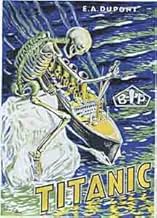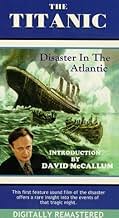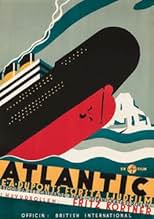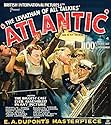Agrega una trama en tu idiomaOn its maiden voyage in April 1912, the supposedly unsinkable RMS Titanic hits an iceberg in the Atlantic Ocean.On its maiden voyage in April 1912, the supposedly unsinkable RMS Titanic hits an iceberg in the Atlantic Ocean.On its maiden voyage in April 1912, the supposedly unsinkable RMS Titanic hits an iceberg in the Atlantic Ocean.
- Dirección
- Guionistas
- Elenco
Gordon James
- Capt. Collins
- (as Sydney Lynn)
- Dirección
- Guionistas
- Todo el elenco y el equipo
- Producción, taquilla y más en IMDbPro
Opiniones destacadas
I was very surprised that I found this 1929 film on YouTube today.. I had no idea it existed and I was excited to see a talking picture made only a decade and a half after the disaster. However, my excitement turned out to be rather muted, as instead of having a grand scope (as ANY picture about the Titanic should have), it looks amazingly claustrophobic. Despite the ship having about 3300 folks aboard (counting crew and passengers), you mostly see scenes with a small handful of folks in them!! I think this is for two reasons. First, the film was obviously made on the cheap. Second, 1929 was the first year for sound pictures in the UK and like the earlier American films of 1927-28, the sound technology was primitive and they had no idea how to film large rooms full of people. Instead, folks had to stand around hidden microphones and talk...which seems unnatural when you see such movies.
As for the title, apparently the White Star Line had a lot of nerve and wouldn't allow the studio to use the name 'Titanic'. I am no barrister, so I have no idea about British law, but this seems more a ploy by White Star than a legitimate case where a copyright or trademark is involved. The sinking of the Titanic was a historical event and mentioning this and the ship's name seem reasonable...and I am not sure why the studio caved and named the movie 'Atlantic' instead of 'Titanic'...but they did.
One thing that was bad about the movie but isn't the filmmakers' fault is that the print is rather jerky and it jiggles a bit. You probably won't need Dramamine to watch the picture, but it is noticeable and annoying.
Another thing to note is that there apparently were several versions of the movie. In the earliest days of sound, they studios had no idea how to dub films into other languages...so they filmed multiple versions in various languages. Laurel & Hardy did this, the Bela Lugosi version of "Dracula" has another version starring a Mexican count and with "Atlantic", they filmed it in German, English AND as a silent (as most theaters didn't have the technology to play sound films yet). And, after finishing the filming, the film was re-cut and French language scenes were added. I saw the English language version...and have no idea if these other versions even exist today nor where you can find them if they do exist.
The movie is odd in that it just begins on the ship in a small drawing room just before the ill-fated crash. I checked...the print I saw WAS the entire 90 minute picture and the normal introduction apparently just wasn't made. This provided little in the way of suspense and over an hour of the film consists of what happens after the ship collides with an iceberg. And, since it was made with very few extras and cast, the whole thing seems a bit small and anticlimactic. But I do cut the film some slack because of when it was made....expecting the same spectacle as in the Nazi propaganda film "Titanic" (1943) or "A Night to Remember" (1958) or "Titanic" (1997) would be ridiculous. Cramped productions were certainly the norm until about 1930-31....and, in hindsight, it might have worked better had they just waited a year or so to make the movie. Additionally, the film lacks reasonably well developed characters and even for 1929, it was a bit of a disappointment in this regard. So, overall it's a very mixed bag for 1929...and a film that must have impressed back in the day but which became quickly dated as well. Mostly of value to the curious and film historians. I give it a 5 because it is watchable and some of the scenes were well made...but overall, it is disappointing and cramped!
As for the title, apparently the White Star Line had a lot of nerve and wouldn't allow the studio to use the name 'Titanic'. I am no barrister, so I have no idea about British law, but this seems more a ploy by White Star than a legitimate case where a copyright or trademark is involved. The sinking of the Titanic was a historical event and mentioning this and the ship's name seem reasonable...and I am not sure why the studio caved and named the movie 'Atlantic' instead of 'Titanic'...but they did.
One thing that was bad about the movie but isn't the filmmakers' fault is that the print is rather jerky and it jiggles a bit. You probably won't need Dramamine to watch the picture, but it is noticeable and annoying.
Another thing to note is that there apparently were several versions of the movie. In the earliest days of sound, they studios had no idea how to dub films into other languages...so they filmed multiple versions in various languages. Laurel & Hardy did this, the Bela Lugosi version of "Dracula" has another version starring a Mexican count and with "Atlantic", they filmed it in German, English AND as a silent (as most theaters didn't have the technology to play sound films yet). And, after finishing the filming, the film was re-cut and French language scenes were added. I saw the English language version...and have no idea if these other versions even exist today nor where you can find them if they do exist.
The movie is odd in that it just begins on the ship in a small drawing room just before the ill-fated crash. I checked...the print I saw WAS the entire 90 minute picture and the normal introduction apparently just wasn't made. This provided little in the way of suspense and over an hour of the film consists of what happens after the ship collides with an iceberg. And, since it was made with very few extras and cast, the whole thing seems a bit small and anticlimactic. But I do cut the film some slack because of when it was made....expecting the same spectacle as in the Nazi propaganda film "Titanic" (1943) or "A Night to Remember" (1958) or "Titanic" (1997) would be ridiculous. Cramped productions were certainly the norm until about 1930-31....and, in hindsight, it might have worked better had they just waited a year or so to make the movie. Additionally, the film lacks reasonably well developed characters and even for 1929, it was a bit of a disappointment in this regard. So, overall it's a very mixed bag for 1929...and a film that must have impressed back in the day but which became quickly dated as well. Mostly of value to the curious and film historians. I give it a 5 because it is watchable and some of the scenes were well made...but overall, it is disappointing and cramped!
let me firstly say that too many of these reviewers ,particularly the film student,are viewing the film in a modern context and not as a film made at the coming of sound.In an interview given by John Longden for the BBCs programme "Yesterdays witness" he stated that the ridiculously long pauses between dialogue were entirely the idea of the director.So it is unfair to blame the actors for this.Also in that same programme sound men were interviewed.They said that the effects were recorded on a liner berthed at Tilbury.The ship was linked by phone line to Elstree studios.Before each effect someone would come on the line to describe the effect and it would be recorded at Elstree.The problems with early sound films were quite apparent here.few directors here or in America had the skill of Hitchcock in adapting to the new medium.In fact one should praise the attempt to tell the story in what was then effectively a new medium rather than decry the effort some 84 years later because it is old fashioned.no doubt in the year 2097 young film students will be looking at the like of Man of Steel and chuckling at its antique quaintness.
For some reason this 1929 film was titled Atlantic when it could have easily been titled Titanic, or something with "Titanic" in its title (however it has been released on video as Titanic.) I suppose they might have titled it Atlantic due to fictional characters and stories that didn't really happen on The Titanic and its fateful voyage, but the story of the film is clearly the disaster that happened to The Titanic. The ship in the film is crossing The Atlantic, and enters areas known to have icebergs. Many of the characters introduced are wealthy types, and we know there were very rich and prominent passengers on The Titanic. Some of the characters include: A husband and father, who cheats on his wife during the voyage; his wife, who tearfully knows her husband was with another woman; their daughter, who outspokenly resents her father for cheating on her mother; a recently wed couple with child on the way; a wheelchair bound gentleman who seems to become the wisdom during the crisis; his wife, who will not leave his side when it's "women and children first;" and a man who seems to drink heavily even before the disaster happens. During the voyage the ship strikes an iceberg, and begins to sink. Lifeboats are being filled with women and children as the ship sends S.O.S. Pandemonium breaks out with many passengers, but our main characters seem to fall into a sad calmness. There is a gathering of many passengers in a lounge, and they drink or play cards to pass the time while waiting to die. On another part of the ship, people are huddled together and singing, "Nearer My God To Thee." Soon all goes black and we know the ship has gone down. This is where the film ends, and there are no scenes of the lifeboats after the sinking. Nor are we shown any scenes of surviving characters, or a rescue ship. Obviously many facts of what happened on The Titanic are correctly portrayed, but other events in Atlantic are either incorrect to The Titanic's disaster, or added as fiction. Atlantic was released by British International Pictures, and the quality of this feature is fine. The film has its typical (of the era) share of crudeness (grainy, jumping, lighting, editing), and there are several instances where it seems like a silent film. There are a couple instances where cheerful music seems very inappropriate to situations going on in the film, (I don't mean when the band begins to play as passengers are being put in lifeboats; this inappropriate music is before the ship strikes the iceberg.) There are a few instances of continuity errors in Atlantic. Atlantic does not attempt much in the way of special effects, but what is attempted is nicely done. The sinking of the ship is not shown, but is indicated when the screen goes black one final time. Having the film end right at the sinking creates a feeling of incompleteness, and it seems the story should have had a more meaningful conclusion. The acting in Atlantic is fair to good, and the film as a whole is fair to good. I found the film to be more thought-provoking than exciting, and it is an interesting disaster effort.
No movie with Madeleine Carroll in its cast could possibly be unwatchable. That said, I have to add that this British film comes close. The story takes place on board the `SS Atlantic' and it's loosely based on the `Titanic's' unfinished voyage. The word `unsinkable' is spoken, the liner strikes an iceberg, and we hear a heavenly choir sing `Nearer My God to Thee.' The doomed passengers eventually take over the anthem, in a clever bit of sound work. But the year of the film's release (1929) means that a modern viewer has to accept otherwise primitive sound and many of the acting conventions of silent films and the stage. These aren't problems. The film's major flaw is pacing, and pacing had been well developed in silents. However, if the dialog were delivered at a realistic speed, the movie's running time would be cut in half. The intended effect was drama (and clarity in a new medium), but the result unhappily is tiresome now. The film's structure is preposterously illogical and inept. Paradoxically, I found certain details of the editing quite modern in technique: fine, abrupt cuts from one area of the ship to another, sometimes even on sound effects. Although we're on board the `Atlantic' from the first shot, we were well over 4 minutes into the movie before I discovered that fact. There are long, intrusive musical passages by the ship's dance orchestra. (Entertaining, easy sound.) Personal stories are presented in an utterly uninvolving and unconvincing way. Don't even think of spectacle. The berg is a tiny thing and the exterior damage it does to the ship's hull is a minor dent. However, the scenes of passengers swarming into the lifeboats - clearly staged on a real liner, presumably tied up to a dock - generate great excitement. Other than the glorious Miss Carroll, these sequences are the film's only points of excellence. As the movie and the ship near their end, the screen goes totally black several times when the power generators begin to fail. Their last, eternal blackout is the end of the film, with a sunset/sunrise tacked on, a clumsy symbolic effect. `Atlantic' is a cinema curiosity. At best.
Yes I know "talkies" had just been invented for the cinema 2 years earlier when this was produced in 1929 but this film showed that much had to learnt about the art of producing films.It comes over as a filmed "hammy" stage play with the actors melodramatically enunciating their lines,rolling their eyes, using too many pregnant pauses and using gestures more appropriate to silent cinema, which I suppose was normal during the process of educating them to appear more naturalistic on screen.The gaps between lines spoken should have been tightened up during editing as it considerably slows the film.It is now only of interest for Titanic buffs who want to see an early example of this marine accident on film.In next chronological order they could see "Titanic" (1953) A Night to Remember (1958)"Titanic (1997), to see how the cinema's depiction of this tragedy as evolved over the years.There have been many documentaries and TV films made including the atrocious "SOS Titanic" (1979) On my version which is a DVD, David McCallum gives the introduction.It was he who played Harold Bride Marconi's junior wireless operator in "A Night to Remember"(still the best feature film - please read my "Tribute to Walter" comments on IMDb under Howard Morley.demon.co.uk)and gave the commentary on the series of 4 videos entitled "End of a Dream" so he was well qualified to give the narration.Of more interest I found was a recording accompanied by actual photos of the 1912 US Senate hearing which is also on the DVD.Actors speak the actual words spoken by Lightoller 2nd officer, J Bruce Ismay,Managing director of White Star, Harold Bride and others including Gloria Stewart (The "old Rose" in Titanic 1997) whose voice is used for one of the first class women survivors.
¿Sabías que…?
- TriviaThe White Star Line forbade the production company from referring to the ship in this film as The Titanic.
- ErroresSet in 1912, he women's hairstyle and dresses are from 1929.
- Versiones alternativasReleased with separate English, French and German soundtracks.
- ConexionesAlternate-language version of Atlantik (1929)
- Bandas sonorasWalking With Susie
(uncredited)
Written by G.H. Elliott
Played by the ship's band as Larry and Monica enter the Smoking Room.
Selecciones populares
Inicia sesión para calificar y agrega a la lista de videos para obtener recomendaciones personalizadas
Detalles
- Fecha de lanzamiento
- País de origen
- Idioma
- También se conoce como
- Titanic: Disaster in the Atlantic
- Locaciones de filmación
- Productora
- Ver más créditos de la compañía en IMDbPro
Taquilla
- Presupuesto
- GBP 2,000 (estimado)
- Tiempo de ejecución1 hora 30 minutos
- Color
- Relación de aspecto
- 1.20 : 1
Contribuir a esta página
Sugiere una edición o agrega el contenido que falta




































